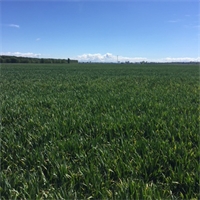28May
Nutrient duo for flourishing pasture
Words supplied by Ballance Agri-Nutrients
“Spring pasture needs both nitrogen and sulphur. A sulphur deficit limits nitrogen uptake, and therefore the response to nitrogen fertiliser,” says Ballance Agri-Nutrients Science Extension Officer Aimee Dawson.
But how can farmers best ensure these nutrients are available for spring pasture to use?
Best time for nitrogen
“Spring, when pasture growth rate peaks, is also typically when nitrogen application response rates (amount of pasture grown in kg DM/ha per kg N/ha applied) are the highest,” says Aimee. Spring response rates might be two to three times higher than in autumn, dependent on location, soil temperature and soil moisture.
Typical nitrogen application response rates at different times
|
|
Typical response rates* (kg DM/ha per kg N/ha)
|
|
Mid to late spring
|
15 - 20
|
|
Autumn
|
5 - 10
|
|
Early winter
|
4 - 8
|
|
Late winter to early spring
|
10 - 15
|
*Rates depend on location, soil temperature and soil moisture.
Nitrogen application response rates are lowest in winter. This is because pasture growth slows down as soil temperatures fall. Any nitrogen applied during winter, or not fully utilised prior to it, is susceptible to leaching during high rainfall periods.
“It can still be effective to apply nitrogen in late winter, early spring or autumn,” says Aimee. “However, monitor the soil temperature during this time to ensure it’s adequate. You want the soil temperature to be 6 °C and rising at 9.00 am to get a response from nitrogen fertiliser.”
Apply sulphur in autumn
Plant-available sulphate sulphur is often lacking in early spring. Over cold, wet winter conditions, sulphate sulphur leaches from the soil similarly to nitrogen, and the bacterial production of sulphate sulphur from organic or elemental sulphur slows down.
“Autumn is a good time to apply elemental sulphur, as it doesn’t leach and sits in the soil over winter, ready to meet spring pasture’s sulphur requirements.” As soil temperatures warm up, soil bacteria become more active and gradually convert elemental sulphur into sulphate sulphur. Elemental sulphur continues to provide a slow drip of sulphur over the season.
Options to consider
When considering products, keep in mind why and when the nutrients are needed and applied. For autumn application, PhaSedN, containing elemental sulphur and nitrogen (as SustaiN), is ideal. A good late winter to early spring option to address short and medium-to-long term sulphur needs is PhaSedN Quick Start. It combines PhaSedN with sulphate of ammonia and provides both elemental and sulphate sulphur. If elemental sulphur is not required, then the SustaiN Ammo range is a good option.
Nitrogen and sulphur content of fertilisers
|
Product
|
Nitrogen %
|
Sulphur %
|
|
Elemental
|
Sulphate
|
|
PhaSedN
|
25
|
29
|
0
|
|
PhaSedN Quick Start
|
31
|
12
|
5
|
|
Sustain Ammo 30
|
30
|
0
|
13
|
|
Sustain Ammo 36
|
35
|
0
|
9
|
For more support, talk to your Ruralco Representative.
Related

Do you approach a bulging wardrobe most days, thinking “Aaaargh! I have so much stuff in my closet,...
Read More

Nationwide appreciation and recognition for the hard mahi put in by our farmers on a daily basis is ...
Read More

Look back and plan ahead to get the most from your autumn sown cereal crop.
Read More

We tend to talk a lot about eating well and exercising, these things are important, but research sug...
Read More

This year’s Ruralco Instore Days prize draw period kicked off on June 1. Every $250 spent with...
Read More

“Take care of your employees and they will take care of your business, it’s that simple....
Read More